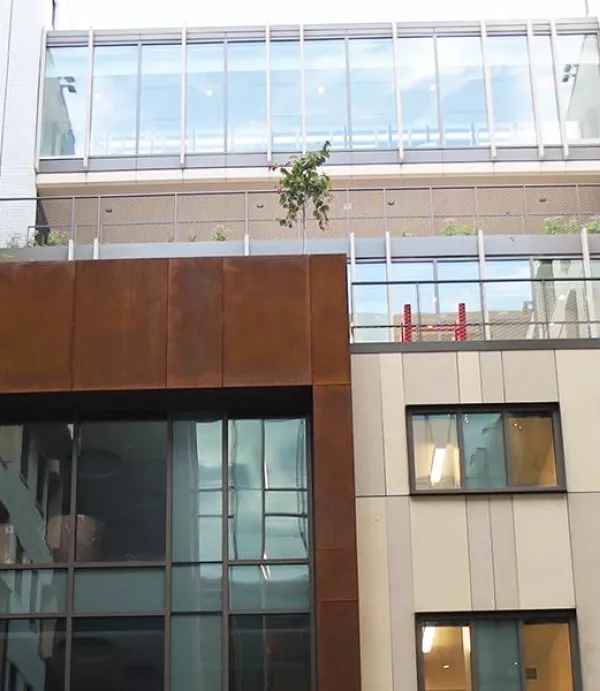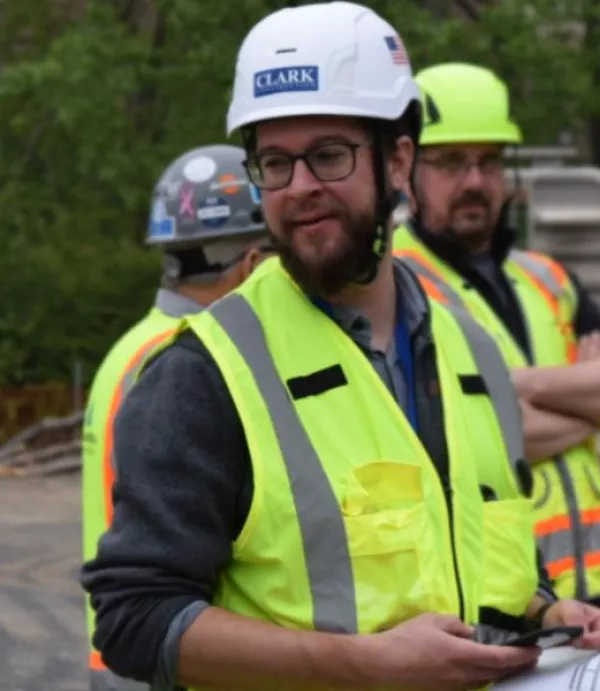Planning for a Healthy Project: Setting the Stage for Success through Early Engagement
October 15, 2019

Healthcare is one of the most rapidly evolving service industries in the world today. Elevating the patient experience and focusing on patient care to attract and retain customers is a top priority for health systems and is influencing healthcare across the country. This focus on creating a service-oriented culture parallels Clark’s continuing work to elevate our customer and client services throughout a project’s lifecycle.
To remain at the forefront of healthcare construction advancements and better serve our clients, Clark established its Healthcare Center of Excellence (COE) in 2013. The COE connects healthcare construction professionals across the company to share best practices and lessons learned. Delivering an average of $1 billion of healthcare work annually, the group collaborates to harness the collective resources and knowledge of the Clark team to provide consistent and exceptional experiences for our healthcare clients. Senior Vice President Barbara Wagner, who leads Clark’s Healthcare COE, recently sat down with Clark healthcare executives Megan Calhoun and Ryan McKenzie to discuss the keys to a healthy project and the importance of early project engagement in setting the stage for success.
HOW DO YOU SET UP A PROJECT TO SUCCEED FROM THE VERY BEGINNING?
MEGAN CALHOUN: The ultimate success of a project lies in the early phases of project planning, long before construction. The first thing we do is work to establish a relationship with the client. Health systems understand that the patient experience is a driver of success. The same is true on Clark projects; the client experience defines our success. Even if a project delivers on time and under budget, it does not necessarily mean it was successful. Several factors determine success, and one of the most important is client satisfaction. The idea of client service and anticipating our clients’ needs is a top priority for us. As a company, we leverage our healthcare COE team to provide knowledge, specialized tools, and resources to engage our clients in meaningful ways. This helps Clark earn our clients' trust and respect beyond just the construction activities.

RYAN MCKENZIE: One of the ways we set the stage for success is through engagement – specifically how we engage with our clients during the earliest stages of project development. As an example, the average length of client engagement before we will even pursue a project is three years. We spend those three years understanding the client’s needs to establish and build trust. We know how important it is for our healthcare clients to trust us and to see that we are the right partner to help them deliver their next project.
MC: Another example of how we’re adding value early on is through our quarterly Market Insight. The Market Insight is a report compiled with the help of internal economists, business analysts, and public and internal data that analyzes the market over the last quarter and provides insight as to where the market may go in the future. Recently, one of our clients asked us to provide an in-depth look at their local market and make some recommendations for their upcoming program of work. Leveraging our knowledge of the national and local economic trends and resources from our COE, we were able to make recommendations, backed by industry data, which were well received and helped our client in making key decisions
WHAT ARE SOME OF THE RISKS YOU ARE SEEING IN HEALTHCARE CONSTRUCTION TODAY?
MC: We are facing a depleted pool of qualified tradespersons and contractors across the country. While this is impacting the entire construction market, healthcare is even more complex and demands a highly-specialized workforce. There is a lot of construction work – everyone is busy. Our clients are looking for a builder with real-time knowledge of the marketplace and strong relationships with quality trade partners. Clark brings those strengths to the table. It allows us to advise clients on the right time to buy specific trades and helps us ensure they are maximizing their budget.
RM: I think one of the most significant risks in healthcare construction today is not having a design or construction partner that is willing to dig into the weeds of a project. With any early contractor engagement – whether it is a construction manager at-risk (CMAR) contract, a design-build contract, or a preliminary budgeting and constructability exercise – we understand that it is our job to identify and communicate risks. As a company, we believe in transparency. Whether positive or negative, it is our responsibility to inform our clients of possible outcomes and to have a plan in place to mitigate the risks we uncover. The beauty of being involved early on is that we can advise the client on solutions well in advance of any construction.
CLIENTS ARE CONCERNED WITH RISING COSTS AND THE EFFECT ON THEIR CAPITAL PROGRAM. WHAT STRATEGIES ARE WE INCORPORATING TO REDUCE THESE RISKS AND PROVIDE BETTER VALUE?
Every client we work with has a wish list of items they’d like to incorporate into their project, but they often need early guidance on what they can afford. Through our experience and volume of work, Clark has captured historical data to provide an accurate cost-per-square-foot for all types of facilities and departments – from acute care towers in California to cancer centers in Virginia to diagnostic buildings in Texas. We use this data to provide early cost metrics for our clients, helping them understand the number of operating rooms, square footage of NICU space, and quantity of advanced imaging suites that fit into their budget. One of the best ways for clients to maximize their budget is by using integrated delivery methods, such as design-build or CMAR. These methodologies promote early collaboration among the client, builder, designer, and key trade partners. Design-build is very prevalent on the West Coast; on the East Coast, more clients are moving to a CMAR model to realize the benefits of early contractor and stakeholder involvement.
ARE THERE SPECIFIC HEALTHCARE PROJECT RISKS THAT YOUR TEAMS ENCOUNTER TIME AND TIME AGAIN?

RM: Low-voltage integration and installation is a risk on healthcare projects. Often, the client procures this work outside of the building construction and long after design and construction are underway. I think one of Clark’s most unique differentiators is our in-house capability to support clients through this scope of work. S2N Technology Group (S2N) is a wholly-owned subsidiary of Clark that designs, manages, and installs low-voltage and IT work, and they specialize in medical systems. Having this capability in-house is invaluable to the level of service we can provide. S2N’s early engagement often leads to accelerated turnover and activation, which allows patients to start receiving care at the earliest possible date.
MC: In my 15 years working in healthcare preconstruction, I have seen Clark’s early involvement in projects help mitigate two significant risks: commodity price escalation and the timing of medical equipment selection and procurement. When we are engaged early in a project, we can establish a procurement plan that transfers commodity price escalation risk at the most responsible time in the project schedule. Those trade contractors are in a better position to lock in commodity pricing and make the decision to pre-purchase materials for a project. When it comes to medical equipment selection and procurement, we work with the designer and the client to identify potential medical equipment vendors and understand the required infrastructure for each piece of equipment. We can also develop flexible designs that the team can advance – and even in some instances, start to build – before the client makes a final decision about the medical equipment. We focus on determining the last possible “decision date” for each piece of medical equipment. This approach allows our clients to plan appropriately and facilitates an efficient vendor selection process. Turning these risks into known values is a big way we help our healthcare clients set their projects up for success and get the most out of their budgets.
HOW IS CLARK IDENTIFYING OPPORTUNITIES EARLY IN THE PLANNING PHASES TO BRING PROJECTS ONLINE SOONER?
RM: Clients are looking for ways to capitalize on opportunities. The earlier we are involved with our key trade contractors, the more opportunities we have to evaluate timeand cost-saving measures like prefabrication. Off-site prefabrication allows our project teams to realize cost and time savings and achieve greater efficiency, quality control, and safety. Prefabrication also enables us to incorporate just-in-time delivery, avoiding excess materials on the construction site. The MedStar Georgetown University Hospital’s new Surgical Pavilion, which is scheduled to complete in 2021, has a contracted prefabrication package of approximately $7 million and includes structural plenum operating room ceilings and bathroom pods. Additionally, the team is evaluating other elements for prefabrication, such as electrical rooms and MEP skids.
***
All in all, Clark's ability to provide value for our clients through early engagement is one of the best ways we are ensuring healthcare project success across the country. We are committing to our clients early, aligning goals and expectations, and leveraging our in-house services to facilitate stronger client relationships. We are working closely with clients to mitigate significant project risks like rising construction costs, commodity pricing, and the skilled labor shortage. Early engagement also allows for speed-to-market strategies such as prefabrication opportunities and low-voltage system integration during design. Clark strives to be the partner of choice for our clients and serve as an integral part of a collaborative team dedicated to the success of each project.


